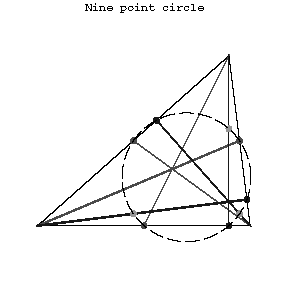Nine-point circle
Euler circle
A circle whose periphery contains the midpoints of the sides of a triangle, the bases of its altitudes, and the midpoints of the segment connecting the orthocentre of the triangle with the vertices. Its radius is equal to one-half of the radius of the circle circumscribed about the triangle. The nine-point circle of a triangle is tangent to the circle inscribed in it and to the three escribed circles. Let  be the orthocentre of a non-equilateral triangle, let
be the orthocentre of a non-equilateral triangle, let  be the centre of gravity, let
be the centre of gravity, let  be the centre of the circumscribed circle and let
be the centre of the circumscribed circle and let  be the centre of the nine-point circle. The points
be the centre of the nine-point circle. The points  then lie on a straight line (Euler's line),
then lie on a straight line (Euler's line),  being the midpoint of the segment
being the midpoint of the segment  , and the pair of points
, and the pair of points  harmonically subdivides the pair of points
harmonically subdivides the pair of points  .
.

Figure: n066750a
References
| [1] | S.I. Zetel', "A new geometry of triangles" , Moscow (1962) (In Russian) |
| [2] | D.I. Perepelkin, "A course of elementary geometry" , 1 , Moscow-Leningrad (1948) (In Russian) |
Comments
Sometimes the nine-point circle is referred to as the Feuerbach circle. The fact that the nine-point circle is tangent to the inscribed circle and the three escribed circles is Feuerbach's theorem.
More generally one has the nine-point conic and the eleven-point conic determined by a projective base  (giving a coordinate system) in the projective plane, cf. [a2], Sects. 16.5.5.1, 16.7.5.
(giving a coordinate system) in the projective plane, cf. [a2], Sects. 16.5.5.1, 16.7.5.
References
| [a1] | H.S.M. Coxeter, "Introduction to geometry" , Wiley (1961) |
| [a2] | M. Berger, "Geometry" , 1–2 , Springer (1987) pp. Sects. 10.11.3, 17.5.4 (Translated from French) |
| [a3] | O. Veblen, J.W. Young, "Projective geometry" , II , Blaisdell (1946) pp. 169; 233 |
Nine-point circle. Encyclopedia of Mathematics. URL: http://encyclopediaofmath.org/index.php?title=Nine-point_circle&oldid=18114